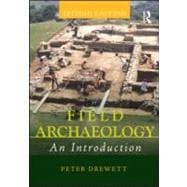
Note: Supplemental materials are not guaranteed with Rental or Used book purchases.
Purchase Benefits
What is included with this book?
| List of figures | p. vii |
| Preface to the First Edition | p. xi |
| Preface to the Second Edition | p. xiii |
| Acknowledgements | p. xv |
| Abbreviations | p. xvii |
| Introduction | p. 1 |
| What is archaeology? | p. 1 |
| What is field archaeology? | p. 3 |
| Who does field archaeology? | p. 6 |
| Theoretical basis of field archaeology | p. 8 |
| Project management | p. 12 |
| What is an archaeological site? How is it formed and transformed? | p. 15 |
| Primary and secondary uses | p. 15 |
| Rubbish and accidental loss | p. 18 |
| Burials | p. 20 |
| Abandonment of a site | p. 21 |
| Natural transformation processes | p. 22 |
| Two examples of abandonment | p. 26 |
| Finding archaeological sites | p. 28 |
| Existing knowledge | p. 28 |
| Documents | p. 30 |
| Aerial photography, satellite images and LiDAR | p. 32 |
| Ground survey | p. 39 |
| Geophysical survey | p. 46 |
| Chemical survey | p. 51 |
| Accidental discovery | p. 53 |
| Recording archaeological sites | p. 54 |
| Written description | p. 54 |
| Archaeological surveying | p. 55 |
| Photography | p. 69 |
| Planning the excavation | p. 72 |
| Permission, funding and the law | p. 72 |
| Site safety | p. 78 |
| Staff, equipment and logistics | p. 83 |
| Approaches to excavation | p. 88 |
| Levels of recovery | p. 93 |
| Digging the site | p. 99 |
| Excavation | p. 100 |
| Recurrent types of context and their excavation | p. 102 |
| Sites without features | p. 112 |
| Artefacts and ecofacts, their recovery and treatment | p. 114 |
| Matrices, phasing and dating sites | p. 115 |
| Excavation and the public | p. 118 |
| Recording archaeological excavations | p. 119 |
| The written record | p. 119 |
| The drawn record | p. 123 |
| The photographic record | p. 130 |
| The finds record | p. 133 |
| Post-fieldwork planning, processing and finds analysis | p. 136 |
| Post-fieldwork planning | p. 136 |
| Finds analysis | p. 138 |
| Interpreting the evidence | p. 151 |
| Interpreting the site's environment | p. 151 |
| Interpretation of the household and its activity areas | p. 153 |
| Interpretation of the community and its activity areas | p. 158 |
| Interpretation of how people lived | p. 160 |
| Publishing the report | p. 163 |
| Archaeological illustration | p. 164 |
| Writing a report | p. 169 |
| Getting a report published in a journal | p. 172 |
| References | p. 174 |
| Index | p. 179 |
| Table of Contents provided by Ingram. All Rights Reserved. |
The New copy of this book will include any supplemental materials advertised. Please check the title of the book to determine if it should include any access cards, study guides, lab manuals, CDs, etc.
The Used, Rental and eBook copies of this book are not guaranteed to include any supplemental materials. Typically, only the book itself is included. This is true even if the title states it includes any access cards, study guides, lab manuals, CDs, etc.